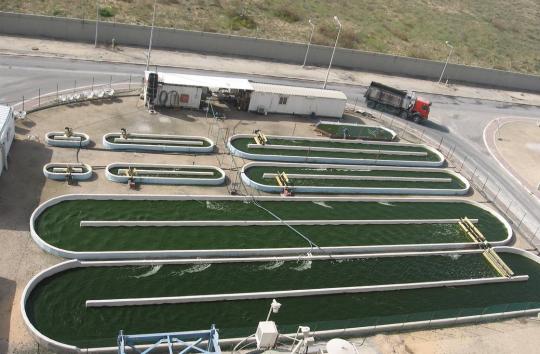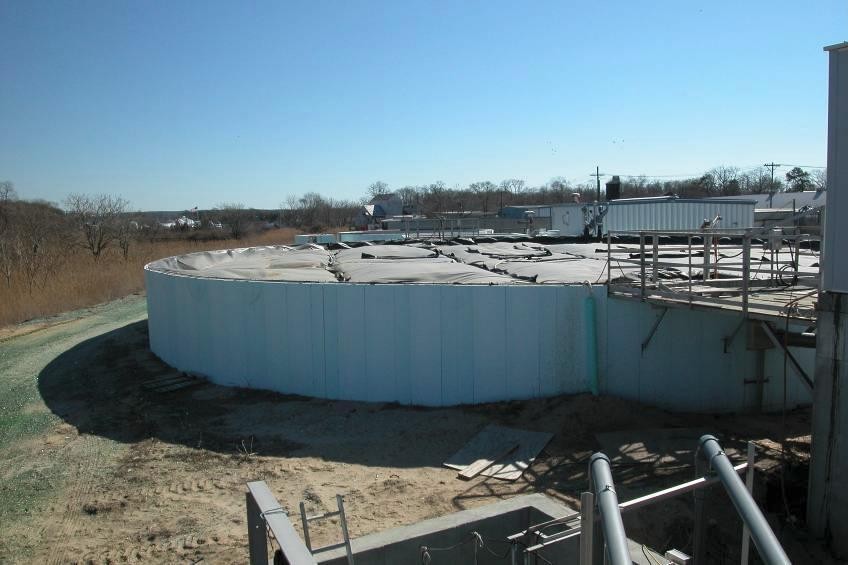With energy security and availability an increasingly pressing issue in the global community, biofuels present a possible alternative to non-renewable energy sources (Demirbas, 2010). Converting terrestrial crops to biofuels, however, involves the drawbacks of high transportation costs, land conversion, and long growth cycles (Demirbas, 2010). This is in addition to the competition that using terrestrial crops for biofuels has with the food supply, a large concern that arises when addressing how to feed the planet. A viable alternative to this current methodology is through the use of algae as the base for the oil in the biofuel. This is actually due to the high lipid content available in the individual cells, which can then be squeezed and extracted to create an oily substance (Scott, 2010).
With yields of 7 to 31 times more energy than the next leading biofuels crop, gross efficiency for algae is by far the highest (Demirbas, 2010). However, the concern arises when viewing the chemical processes needed to break the oily secretions into biodiesel. To accomplish this task, methyl alcohol must be added to the oily secretions to break down the molecules into a more viscous, fluid form (Reijnders, 2009). This now presents the issue of acquisition of methyl alcohol and transportation of the methyl alcohol from the point of manufacture to the chemical plant, where the algal mass is treated. Additionally, the algal mass must be transported from the point of production to the chemical plant, releasing more emissions in the process. This procedure, although complicated, is vital because the pre-treated form of the algae product cannot be easily burned in a diesel engine (Reijnders, 2009).

The benefits of bioalgae (to be used as a biodiesel) also extend to the issue of carbon sequestration (as addressed by the Mission 2013 Terrascope class). If bioalgae were used as the basis for fuel, then the emissions of greenhouse gases through burning would be sequestered in the production of the algae (Reijnders, 2009). This is in slight contrast to type of ethanol derived from corn, which has yet to reach a carbon neutral state. In other words, more energy and carbon is put out into the atmosphere to manufacture this type of ethanol than carbon is absorbed in the process of growing the plants (Deason 2010). Furthermore, the production of corn ethanol is not economically feasible without corn subsidies and requirements for domestically produced corn ethanol in the supply of widely available petroleum products (Deason 2010). Algae based biofuels is being promoted in this case as a manner to reduce the presure on corn-based biofuels and make food more available to consumers.
(Source: Seambiotic, 2008, www.seambiotic.com)
The reason for the existence of corn-based ethanol is more political than economic. The 2007 State of the Union Address presented unreasonable goals for the production of corn-based ethanol; the speech called for the planting of another 66 million acres of corn specifically for ethanol production, in addition to the allocation of the current 71 million acres of corn cropland for ethanol production (Deason 2010). Deason also compiles a table of data summarizing the impact of US corn subsidies on the price of Corn Ethanol. With subsidies, the cost to produce corn ethanol is around $1.09 per gallon. Without subsidies, however, the price of producing a gallon of corn ethanol is around $7.88, over seven times higher. For the consumer, the cost is of subsidized ethanol is only $2.62 per gallon, as compared to $2.92 for imported Cane Ethanol and $3.97 per gallon of gas, which only costs $1.25 to produce (Deason 2010).
The production of ethanol would also drain the supply of potable water available for the irrigation and processing of corn. Furthermore, this redistribution of corn products would remove much of the available edible corn being exported to other countries, and create a highly competitive market for corn, driving the cost of a vast range of food products upwards (Deason 2010).
Algae-based oils show promise as a second biofuels option, despite being a fairly untested concept. There is a limited amount of scientific information available in the field, and as noted by Gallagher, much of the available information is purely theoretical, without ample evidence from commercial applications to fully support or refute the idea. However, algal oil has been successful in a number of cases (Subhadra 2010), so it is beneficial to support continued investment and research in the area. 
According to Subhadra, algae can be adapted to feed on municipal wastewater, manure, or slaughterhouse waste in an anaerobic batch reactor. In this manner, eutrophication, or the runoff off large amounts of nutrients leading to algal blooms, can be prevented (Scott 2010). These often harmful blooms have the potential to destroy fish habitats by removing large amounts of dissolved oxygen and vital nutrients from the water.
To solve the problems and improve the conditions outlined above, general academia has reached a consensus that corn based ethanol production is not a green solution, nor would it be economically wise to grant the governmental subsidies needed to sustain the industry. Therefore, we are in favor of gradually phasing out the production of these items and placing the government subsidies in the hands of researchers who could create the second generation of biofuels, including the existing crops of sugarcane in Brazil.
As a method of limiting the impact on the economy, it would be wise to phase out ethanol derived from direct food crops first, and then to phase out ethanol produced from crops that are not food staples. Since the U.S. is a major producer of corn to be used in ethanol production, the U.S. should be the first to implement this policy. The phasing-out process would also involve gradually reducing government subsidies on ethanol to make production less profitable, and thus provide a disincentive for producing corn for ethanol, rather than producing it for food.
In the U.S., this means that the ethanol incentives must be slowly removed so farmers can adapt and focus on finding new markets for their crops. This agrees with the general acceptance among economic academia that large agricultural subsidies hurt the economy and the economic growth potential. One of the most important economic policies to be phased out is the current requirement that ethanol be part of the gasoline supply. By doing so, this would allow the corn to be reallocated to food alone, and the relative overabundance of crops during the transition process could be somewhat beneficial as a food staple to be exported to countries in need.
Beyond phasing out corn subsidies, the government would have the option to reallocate that money that would have been funneled into corn into the support of research into biofuels from other sources, such as switchgrass and algae. Switchgrass is particularly interesting because it also has the ability to be used for soil conservation and atmospheric carbon dioxide sequestration.
Since significant technological breakthroughs are needed to make second generation biofuels feasible for large production, petroleum companies should be given the opportunity to work with research institutions in developing the technology. Given a significant capital backbone, these initiatives can be very successful, such as the US Department of Energy’s effort to make cellulosic and second generation ethanol cost competitive with petroleum by 2012 (Euractiv, 2009). This is also consistent with the EU’s 2007 commitment to advancing biofuels and cellulosic ethanol (Euractiv, 2009).
Private organizations that have been working to advance second generation biofuels should also be included, as these companies will be the ones to ultimately produce it. The government should place pressure on petroleum companies to invest in the production of these biofuels, but the government should also be wary of the evidence that the petroleum companies or their puppet companies provide. Furthermore, any potential monopoly of a successful biofuel company be discouraged, and competition encouraged to help biofuels gain a larger segment of the fuel supply.
Several helpful institutions that endorse and support gains in second generation biofuels include the European Biodiesel Board, European Bioethanol Fuel Association, and W4B (UK) ltd. (Euractiv, 2009)
The plan to remove subsidies should be conducted over a ten year time period, to allow the economy to adapt. If allowed to go beyond that time period, additional funds should be allocated exclusively for the purpose of promoting and developing biofuels and bioethanol. According to the Terrascope outlook on time, biofuels are a medium term problem; meaning that by 2030, twenty years from now, biofuel use should be widespread and compatible with the continually evolving automotive industry.
Demirbas, A. (2010, December). Use of algae as biofuel sources. Energy Conversion and Management Vol 51, Issue 12; 2738-2749
Scott S A, Davey M P, Dennis J S, Horst I, Howe C J, Lea-Smith D J, Smith A G. (2010). “Biodiesel from algae: challenges and prospects.” Current Opinion in Biotechnology; 21 (3): 277-286. Retrieved November 9, 2010, from http://www.sciencedirect.com/science?_ob=ArticleURL&_udi=B6VRV-4YW8V7F-1&_user=5....
Reijnders L. (2009). “Microalgal and Terrestrial Transport Biofuels to Displace Fossil Fuels.” Energies; 2 (1): 48-56. Retrieved November 11, 2010, from http://www.mdpi.com/1996-1073/2/1/48/pdf.
Deason J. P., Lobkowicz H, Somma D. (2010, August). Growing America's Fuel: an analysis of corn and cellulosic ethanol feasibility in the United States. Clean Technologies and Environmental Policy Vol. 12, Issue 4; 373-380.
Gallagher, B J. (2010). “The economics of producing biodiesel from algae.” Renewable Energy; 36 (1): 158-162. Retrieved November 9, 2010, from http://www.sciencedirect.com/science?_ob=MImg&_imagekey=B6V4S-50N2BFJ-1-6&_cdi=5....
Subhadra B G. (2010) “Sustainability of algal biofuel production using integrated renewable energy park (IREP) and algal biorefinery approach.” Energy Policy; 38 (10): 5892-5901. Retrieved November 9, 2010, from http://www.sciencedirect.com/science?_ob=MImg&_imagekey=B6V2W-506H0Y9-3-C&_cdi=5...
Biofuels: The Next Generation.(2009, July 13). Retrieved November 29, 2010, from Euractiv: http://www.euractiv.com/en/energy/biofuels-generation/article-165951
Seambiotic Ltd. (top photograph). (2008). Seambiotic. Retrieved November 29, 2010, from http://www.seambiotic.com/
Corwin Duck Faciltiy Anaerobic Tank (bottom photgraph), Corwin Duck, Aquebogue, NY. Retrieved November 29, 2010, from http://www.manuremanagement.cornell.edu/Pages/General_Docs/Powerpoint/Aldrich_Status_of_Digesters_NY_PPT.pdf